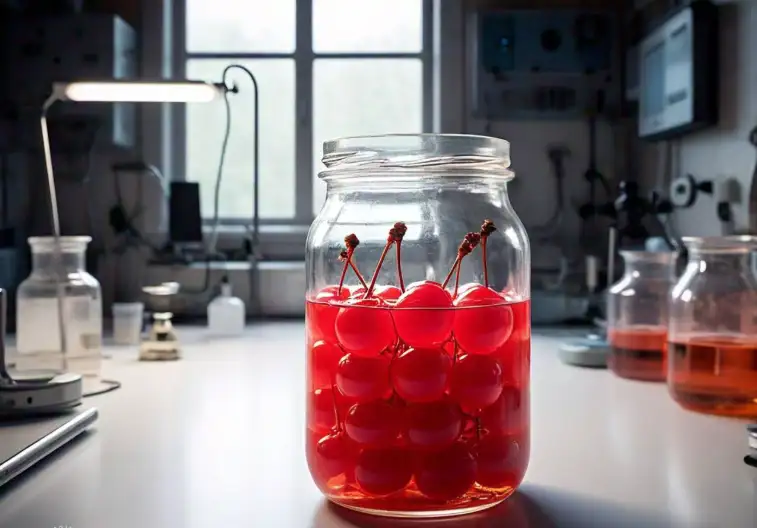Maraschino cherries, with their iconic bright red or green hues, have fascinated and mystified many over the years. A persistent urban myth claims these cherries are preserved in formaldehyde, raising concerns about their safety. In this article, we’ll explore the origins of maraschino cherries, debunk the myths surrounding them, and uncover their cultural and culinary significance.
Myth vs. Fact: Are Maraschino Cherries Preserved with Formaldehyde?
Myth: Maraschino cherries are soaked in formaldehyde.
Fact: This claim is false. The confusion likely arose from a mix-up between formaldehyde and benzaldehyde, a flavoring agent derived from cherry, almond, or walnut pits. Benzaldehyde imparts the cherry-like flavor found in maraschino cherries, but it is entirely safe for consumption.
Maraschino cherries are preserved using sodium metabisulfite, calcium chloride, and citric acid. The vibrant colors come from FDA-approved dyes like Red Dye #40, which is commonly found in other food products like candy and gum. Rest assured, no toxic substances are involved.
The Origin of Maraschino Cherries
Maraschino cherries trace their roots to Dalmatia (modern-day Croatia), where small, sour marasca cherries grew wild. These cherries were preserved in a liqueur called maraschino, made from the cherries’ juice, pits, and leaves. This technique allowed the cherries to retain their flavor and texture for extended periods.
The process gained popularity in Europe, with wealthy patrons favoring these liquor-soaked treats. Over time, various countries began creating their versions, often using locally available cherries and adapting the recipes. By the late 1800s, Americans had adopted the trend, modifying the preservation process to suit domestic preferences.
The Modern Transformation
In the early 1900s, maraschino cherries became a staple in cocktails and desserts. Their use in Manhattans and sundaes cemented their popularity. However, the Prohibition era (1920-1933) significantly impacted their production in the U.S. Since alcohol was banned, manufacturers developed a new brining process that eliminated the need for alcohol.
Ernest Wiegand, a professor at Oregon State University, revolutionized the industry by perfecting a method to preserve cherries without making them mushy. This scientific approach ensured consistency and quality, transforming maraschino cherries into the sweet, colorful treats we recognize today.
Cultural and Culinary Significance
Maraschino cherries are more than just a garnish. They symbolize transformation, evolving from traditional liquor-soaked fruits to widely accessible preserved cherries. In Italy, authentic marasca cherries in maraschino liqueur remain a gourmet delicacy, perfect for enhancing desserts like ice cream and puddings.
In the U.S., maraschino cherries are produced on a large scale, with Oregon being a significant hub. These cherries are indispensable in classic American recipes, from sundaes to pineapple upside-down cakes.
Debunking Other Myths
- Red Dye Safety:
The dye used in maraschino cherries (FD&C Red Dye #40) is approved for food use and is found in many other edible products. Concerns about cancer-causing Red Dye #3 do not apply, as it is not used in maraschino production. - Nutritional Value:
While maraschino cherries are high in sugar due to their preservation process, they are safe to eat in moderation. They are not meant to replace fresh cherries in terms of nutrition. - Indigestion Myths:
Another myth suggests maraschino cherries are indigestible. This claim has no scientific basis; they are processed like any other food.
Tips for Choosing and Enjoying Maraschino Cherries
- For Authenticity: Seek out Italian marasca cherries preserved in maraschino liqueur for a richer flavor profile.
- For Classic Recipes: Use American-style maraschino cherries to garnish cocktails, top desserts, or bake into cakes.
- DIY Approach: You can create your version at home using fresh cherries, sugar syrup, and flavoring agents.
A Sweet Reminder
The story of maraschino cherries is one of resilience and reinvention. From their humble beginnings in Dalmatia to their global presence today, these cherries have transformed in ways that reflect cultural shifts and culinary innovation. Whether in a fancy cocktail or atop a homemade sundae, maraschino cherries continue to bring color and sweetness to our lives.
So, the next time you see that bright red cherry in your drink, you can appreciate its fascinating journey—and enjoy it without fear of formaldehyde.

